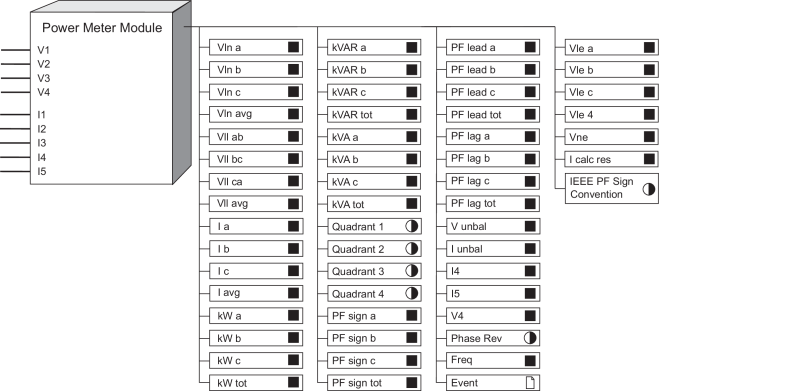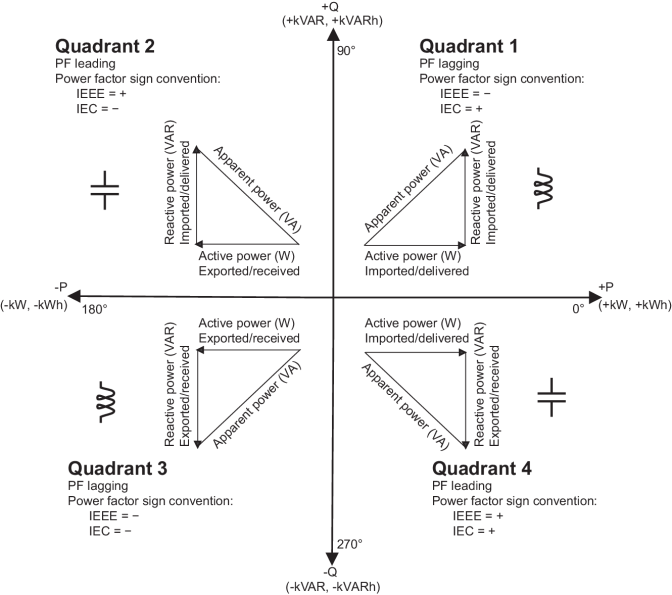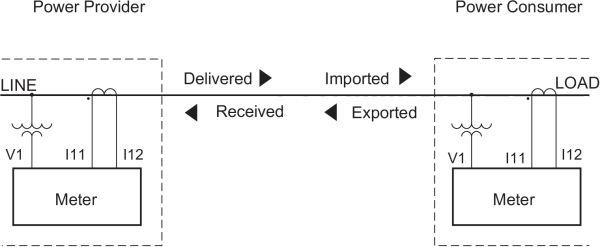Power Meter Module
The Power Meter Module calculates all basic power system quantities based on measured voltage and current input signals.
Module icon
![]()
Overview
The Power Meter Module has three forms: the regular Power Meter, the Meter Units (MU) Power Meter, and the High Speed (HS) Power Meter. Regular Power Meter modules use scaling factors to obtain high-accuracy measurements of primary transformer levels. MU Power Meter modules display true secondary transformer levels; i.e. readings based on the voltage and current after they have been transformed to fall within the input ranges of the device. HS Power Meter Modules update their measurement as fast as once per half-cycle (rather than once per second).
NOTE: Not all ION devices support the High Speed Power Meter Module.

NOTE: The registers and settings available in this module depend on the device or node you are configuring, as well as its firmware and template versions. Not all registers or settings are available on all devices or the Virtual Processor, and labels may vary.
Inputs
All Power Meter modules are enabled by default. They cannot be disabled.
 V1-V4 and I1-I5
V1-V4 and I1-I5
These inputs are the sampled waveforms originating from your polyphase or single-phase power system. Power Meter module inputs are linked to output registers on either the Data Acquisition module or the Instrument Transformer Correction (ITC) module, depending on the meter type. These links cannot be changed.
The physical connection for I4, I5, and V4 are not present on all ION meters. Those meters with connections for these inputs are generally used to monitor neutral and earth ground currents and voltage. I4 is generally connected to the neutral conductor in a Wye system, I5 is generally used for monitoring the earth-ground current, and V4 is typically used to measure the potential between neutral and earth-ground.
Although all ION meters have an I4 output register, the I4 input is not always present. Those meters that do not have the I4 input derive I4 from a residual current calculation (see the I4 output register below). Refer to your device documentation for more information.
Setup registers
The setup registers for the Power Meter module define the characteristics of the power system being monitored and influence the calculations that are performed.
NOTE: The setup register settings apply to all Power Meter module types (Power Meter, MU Power Meter and HS Power Meter).
 Volts Mode
Volts Mode
This register reflects the power system configuration and determines the mode of calculation (4W-Wye, 3W-Wye, or Delta, for example). The device may also offer a demonstration mode that generates dynamic artificial readings for all real-time measurement output registers. Refer to the appropriate device’s Installation document for details about which configuration is appropriate under different circumstances, as well as detailed wiring diagrams.
 PT Prim
PT Prim
If potential transformers (PTs) are used on the voltage V1 - V3 inputs, this register should be set to the primary winding rating for the PTs. If direct connection is used, this register should be set to the full-scale ratings of the V1 - V3 inputs.
NOTE: The PT and CT scaling factors are not used by the Meter Units Power Meter (MU Power Meter) module calculations.
 V4 PT Prim
V4 PT Prim
If a potential transformer (PT) is used on the V4 input, this register should be set to the primary winding rating for the PT. If direct connection is used, this register should be set to the full-scale rating of the V4 inputs.
 PT Sec
PT Sec
If potential transformers (PTs) are used on V1 - V3 inputs, this register determines the secondary winding rating for the PTs. If direct connection is used, this register sets the full-scale ratings of the V1 - V3 inputs.
 V4 PT Sec
V4 PT Sec
If a potential transformer (PT) is used on the V4 input, this register determines the secondary winding rating for the PT. If direct connection is used, this register sets the full-scale rating of the V4 input.
 CT Prim
CT Prim
This register should be set to the Current Transformer (CT) primary winding rating for inputs I1 - I3.
 CT Sec
CT Sec
This register should be set to the Current Transformer (CT) secondary winding rating for inputs I1 - I3.
 I4 CT Prim, I5 CT Prim
I4 CT Prim, I5 CT Prim
These registers should be set to the Current Transformer (CT) primary winding rating for inputs I4 and I5. The I5 CT Prim register will exist only on those meters that support I5.
 I4 CT Sec, I5 CT Sec
I4 CT Sec, I5 CT Sec
These registers should be set to the Current Transformer (CT) secondary winding rating for inputs I4 and I5. The I5 CT Sec register will exist only on those meters that support I5.
 V1 – V4 Polarity
V1 – V4 Polarity
These registers should be set to the polarity of the V1, V2, V3, and V4 potential transformers (PT), respectively. The V4 Polarity register only exists on certain meters.
NOTE: The Polarity setup register defines the sign of a measured value. Changing the polarity of a measured value can affect modules that are linked to this register in unanticipated ways. The polarity setting may be lost because the values are squared, or only the value and not the polarity is provided to linked modules. For example, when interpolating V2 in a V1/V3 system, if V1 is inverted then V2 may be interpolated incorrectly.
 I1 – I5 Polarity
I1 – I5 Polarity
These registers should be set to the polarity of the I1, I2, I3, and I4 Current Transformers (CT), respectively. The I5 Polarity register will exist only on those meters that support I5.
NOTE: The Polarity setup register defines the sign of a measured value. Changing the polarity of a measured value can affect modules that are linked to this register in unanticipated ways. The polarity setting may be lost because the values are squared, or only the value and not the polarity is provided to linked modules. For example, when interpolating V2 in a V1/V3 system, if V1 is inverted then V2 may be interpolated incorrectly.
 PhaseOrder
PhaseOrder
This register defines the expected rotation of voltage phases.
 Phase Lbls
Phase Lbls
This register determines the phase label formats given to the output registers.
 Probe Type
Probe Type
This register determines the Current Probe Inputs setting.
 kVA tot Method
kVA tot Method
This register determines the method used to calculate kVA total. When set to vector sum, kVA total is calculated using this formula:

When set to scalar sum, kVA total is calculated using this formula:
- kVAa + kVAb + kVAc
 PF Sign Convention
PF Sign Convention
This register determines which sign convention (IEEE or IEC) is used for the PF Sign a, PF Sign b, PF Sign c and PF Sign tot output registers, and therefore how it is displayed on the front panel when the PF Symbol register in the Display Options module is set to “+/–”. The options are ieee or iec; see the Detailed module operation sections for more details.
 Nominal Frequency
Nominal Frequency
This register sets the nominal frequency used by the meter. The options are 50Hz or 60Hz.
Output registers
The output registers of the Power Meter module contain all the current and voltage-based values that are measured or calculated by the meter.
 Vln a, Vln b, Vln c
Vln a, Vln b, Vln c
These three registers contain the RMS line-to-neutral voltages on phase A, B, and C, respectively. Note that if Volts Mode is delta, these outputs are not available. If Volts Mode is single, Vln c is not available.
 Vln 4
Vln 4
This register contains the RMS line-to-neutral voltage on phase 4.
 Vln avg
Vln avg
This register contains the average of Vln a, Vln b and Vln c. Note that if Volts Mode is single, this register will be set to the average of Vln a and Vln b only. If Volts Mode is delta, this output is not available.
 Vll ab, Vll bc, Vll ca
Vll ab, Vll bc, Vll ca
These three registers contain the RMS line-to-line voltages from phases B to A, C to B, and A to C, respectively. If Volts Mode is single then Vll bc and Vll ca will read not available.
 Vll avg
Vll avg
This register contains the average of Vll ab, Vll bc and Vll ca. Note that if Volts Mode is single, this output is not available.
 Vle a, Vle b, Vle c, Vle 4
Vle a, Vle b, Vle c, Vle 4
These registers contain the RMS line-to-earth voltages on phase A, B, C and phase 4 respectively. Note that if Volts Mode is singleVle c is not available.
 Vne
Vne
This register contains the RMS neutral-to-earth voltage.
 I a, I b, I c
I a, I b, I c
These three registers contain the RMS current of phases A, B, and C respectively. Note that if Volts Mode is single, Ic is not available.
 I avg
I avg
This register contains the average of I a, I b and I c. Note that if Volts Mode is single, this register averages I a and I b only.
 I calc res
I calc res
This register contains the calculated RMS residual current.
 kW a, kW b, kW c
kW a, kW b, kW c
These three registers contain the real power for phases A, B, and C, respectively. Note that a negative value indicates reverse kW. If Volts Mode is delta, kW a and kW b will be not available. If Volts Mode is delta or single, kW c is not available.
 kW total
kW total
In Wye mode, this register contains the sum of kW a, kW b, and kW c. Note that a negative value indicates reverse kW. If Volts Mode is single, this register will contain the sum of kW a and kW b.
 kVAR a, kVAR b, kVAR c
kVAR a, kVAR b, kVAR c
These three registers contain the reactive power for phases A, B, and C, respectively. Note that a negative value indicates reverse kVAR. If Volts Mode is delta, kVAR a and kVAR b will be not available. If Volts Mode is Delta or single, kVAR c is not available.
 kVAR total
kVAR total
In Wye mode, this register contains the sum of kVAR a, kVAR b, and kVAR c. Note that a negative value indicates reverse kVAR. If Volts Mode is Single, this register will contain the sum of kVAR a and kVAR b.
 kVA a, kVA b, kVA c
kVA a, kVA b, kVA c
These registers contain the RMS value of apparent power for phases A, B, and C, respectively. Note that if Volts Mode is delta, kVA a and kVA b will be not available. If Volts Mode is delta or single, kVA c is not available.
 kVA total
kVA total
This register contains the total apparent power over three phases, as determined by the kVA tot Method setup register.
 Quadrant 1, Quadrant 2, Quadrant 3, Quadrant 4
Quadrant 1, Quadrant 2, Quadrant 3, Quadrant 4
When the Quadrant output registers are on, they indicate the quadrant where apparent power resides. The table below states the conditions that create the ON output in each register.
| kW | kVAR | |
|---|---|---|
| Quadrant 1 | kW ≥ 0 | kVAR ≥ 0 |
| Quadrant 2 | kW < 0 | kVAR ≥ 0 |
| Quadrant 3 | kW < 0 | kVAR < 0 |
| Quadrant 4 | kW ≥ 0 | kVAR < 0 |
Note that the Quadrant output registers are only available on the regular and Meter Units (MU) Power Meter modules.
 PF sign a, PF sign b, PF sign
c
PF sign a, PF sign b, PF sign
c
These registers contain the power factor on phase A, B, and C, respectively. The values can range from 0 to 100 and -100 to -0. A negative value indicates that the power factor is lagging. A positive value indicates that the power factor is leading. Note that if Volts Mode is delta, PF sign a and PF sign b will be not available. Note that if Volts Mode is delta or Single, PF sign c will be not available. See the Detailed module operation section for more details.
 PF sign tot
PF sign tot
In Wye mode, this register contains the total power factor on phases A, B, and C. The value can range from 0 to 100 and -100 to -0. Note that if Volts Mode is single, this register will contain the total PF on phases A and B.
 PF lead a, PF lead b, PF lead c
PF lead a, PF lead b, PF lead c
These three registers contain the leading power factor on phases A, B, and C, respectively. The value can range from 0 to 100. Note that if Volts Mode is delta or the power factor is lagging, PF lead a and PF lead b will be not available. If Volts Mode is delta or single, or the power factor is lagging, PF lead c will be not available.
 PF lead tot
PF lead tot
In Wye mode, this register contains the total leading power factor on phases A, B, and C. The value can range from 0 to 100. Note that if Volts Mode is single, this register will contain the total leading power factor on phases A and B. If the total power factor is lagging, this register will be not available.
 PF lag a, PF lag b, PF lag c
PF lag a, PF lag b, PF lag c
These three registers contain the lagging power factor on phases A, B, and C, respectively. The values can range from 0 to 100. Note that if Volts Mode is delta or the power factor is leading, PF lag a and PF lag b will be not available. If Volts Mode is delta or single, or the power factor is leading, PF lag c will be not available.
 PF lag tot
PF lag tot
In Wye mode, this register contains the total lagging power factor on phases A, B, and C. The value can range from 0 to 100. Note that if Volts Mode is single, this register will contain the total lagging power factor on phases A and B. If the total power factor is leading, this register will be not available.
 IEEE PF Sign Convention
IEEE PF Sign Convention
This register indicates if IEEE PF Sign Convention has been selected. A value of true indicates that IEEE PF Sign Convention is selected. A value of false indicates that iec sign convention is selected.
 V unbal
V unbal
This register contains the percentage deviation from Vln avg for the voltage phase having the greatest unbalance. It is calculated as follows:
| WYE MODE | DELTA MODE |
|---|---|
| (Largest Deviation from Vln avg / Vln avg) x 100% | (Largest Deviation from Vll avg / Vll avg) x 100% |
For example:
- Vln a = 13,700 V
- Vln b = 13,900 V
- Vln c = 13,700 V
Vln avg = 13,700 + 13,900 + 13,700 / 3 = 41,300 / 3 = 13,767 V
Vln B (13,900) has the largest deviation from Vln avg (13,767)
ABS ((Vln b – Vln avg) / Vln avg) x 100% = ABS ((13,900 – 13,767) / 13,767) x 100% = 0.96%
 I unbal
I unbal
This register contains the percentage deviation from I avg for the current phase having the greatest unbalance.
(Largest Deviation from I avg / I avg) x 100%
 I4, I5
I4, I5
If the meter has these physical current connections, those RMS values are displayed. If there is no physical connection they provide calculated residual current.
 Phase Rev
Phase Rev
This register indicates if there is a Phase reversal. When the voltage phases do not rotate in the sequence specified by the PhaseOrder setup, this register is on. Note that if Volts Mode is single, this register is not available.
 Freq
Freq
This register displays the measured Fundamental frequency of phase A voltage.
Some devices support Fundamental frequency measurement on any connected voltage input.
 Event
Event
All events are recorded in the Event register.
Possible events and their associated priority numbers are:
| Event priority group | Priority | Description |
|---|---|---|
| Setup Change | 10 | Setup registers, input links or labels have been changed. |
The Event output register stores the following information for each ION event: time stamp, priority, cause, effect, and any values or conditions associated with the cause and effect.
Detailed module operation
Values for power factor and energy direction are interpreted according to the conventions shown in the diagrams below.


True PF and displacement PF
The meter supports true power factor and displacement power factor values:
- True power factor includes harmonic content.
- Displacement power factor only considers the fundamental frequency.
NOTE: Unless specified, the power factor displayed by the meter is true power factor